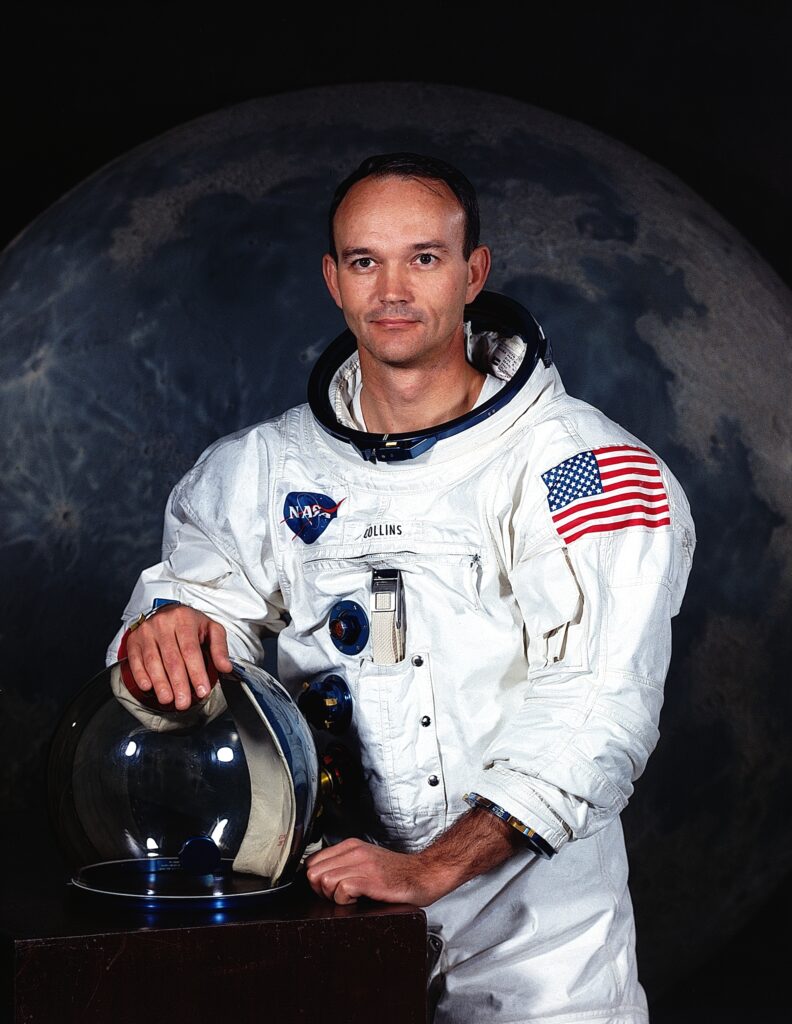Piloted the command module on Apollo 11, the first manned Moon-landing mission.
Michael Collins was born on October 31, 1930, in Rome, Italy. His father was a major general in the U.S. Army and Michael grew up in Italy, Oklahoma, New York, and Puerto Rico. He graduated from Saint Albans School in Washington, D.C. and received a Bachelor of Science degree from the United States Military Academy, West Point in 1952. He also attended the Harvard Business School in the advanced management program. He has honorary degrees from six colleges and universities.
After leaving West Point, Michael Collins entered the U.S. Air Force, in part to avoid appearances of nepotism, as his uncle was Chief of Staff of the US Army at the time. Collins completed flight training in Columbus, Mississippi then graduated from advanced day fighter training at Nellis Air Force Base (AFB), Nevada, flying F-86 Sabre jets. He was then assigned to the 21st Fighter-Bomber Wing at George AFB, California. In 1954 he and his unit were relocated to Chaumont-Semoutiers Air Base in France. In 1956 he was deployed to West Germany, then attended aircraft maintenance officer school at Chanute AFB in Illinois. Collins next served as an experimental test pilot at the Air Force Flight Test Center, Edwards Air Force Base, California, from 1960 to 1963. He has logged more than 5000 hours of flying time.
Michael Collins was part of the third group of astronauts named by NASA, in October 1963 (he was inspired to apply for the program after John Glenn’s spaceflight in February 1962). Collins was the Pilot on the three-day Gemini X mission in July 1966 and became the third American to walk in space, completing two extravehicular activities (EVAs). His second spaceflight was as Command Module pilot of the historic Apollo 11 mission in July 1969. He remained in lunar orbit while Neil Armstrong and Buzz Aldrin became the first men to walk on the Moon. Michael Collins has logged 266 hours in space, of which one hour and 27 minutes was spent in EVA.
Gemini X was launched on July 18, 1966; John Young commanded the mission and he and Collins share the accomplishments of that record-setting flight. These include successfully rendezvousing and docking with a separately launched Agena target vehicle and, using the power of the Agena, maneuvering the Gemini spacecraft into another orbit for a rendezvous with a second, passive Agena. Gemini X also set a world altitude record and Collins became the nation’s third spacewalker, completing two spectacular EVAs, the first person to perform two spacewalks on one flight. Collins’ skillful performance during the EVAs included the recovery of a micrometeorite detection experiment from the passive Agena.
Michael Collins was Command Module pilot on Apollo 11, launched from Kennedy Space Center on July 16, 1969. On July 21, Collins performed the final re-docking maneuvers following a successful lunar orbit rendezvous with Armstrong and Aldrin after Eagle’s ascent from the lunar surface. With the safe landing of Apollo 11 on July 24, 1969, Collins ended his second, and last space flight (while training for Apollo 11 he had requested it be his last mission).
Upon leaving NASA in January 1970, Michael Collins became Assistant Secretary of State for Public Affairs. In April 1971, he joined the Smithsonian Institution as Director of the National Air and Space Museum, responsible for planning and construction of the new museum building, which opened to the public in July 1976. In April 1978, Collins became Undersecretary of the Smithsonian Institution; that same year he retired from the Air Force with the rank of Major General. From 1980 to 1985, he was Vice President of the LTV Aerospace and Defense Company.
He is author of an autobiography, Carrying the Fire (1974). He followed it with Flying to the Moon and Other Strange Places (1976), and in 1988 wrote Liftoff: The Story of America’s Adventure in Space. General Collins has been awarded the Presidential Medal for Freedom in 1969, the NASA Exceptional Service Medal, the Air Force Command Pilot Astronaut Wings, and the Air Force Distinguished Flying Cross. Asteroid 6471 Collins is named in his honor.

